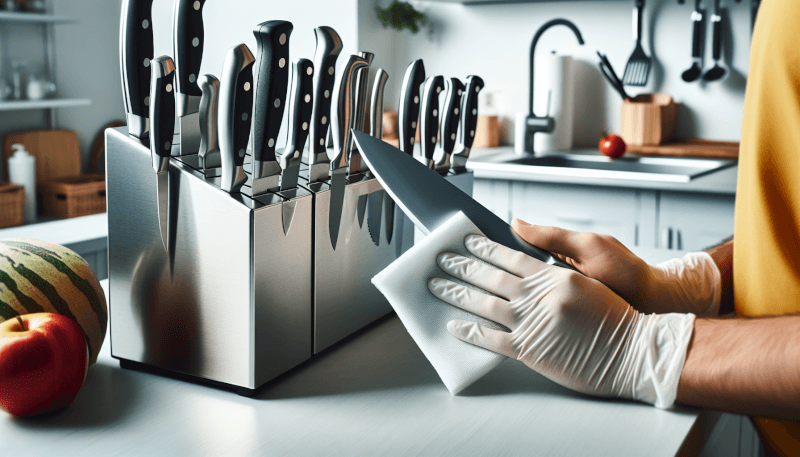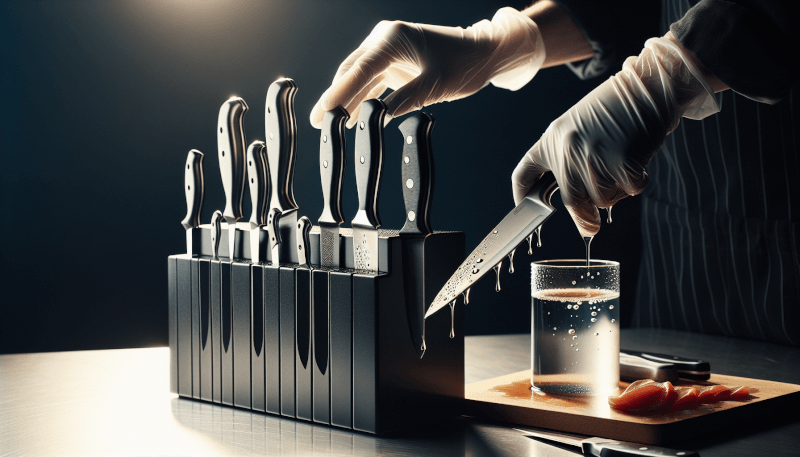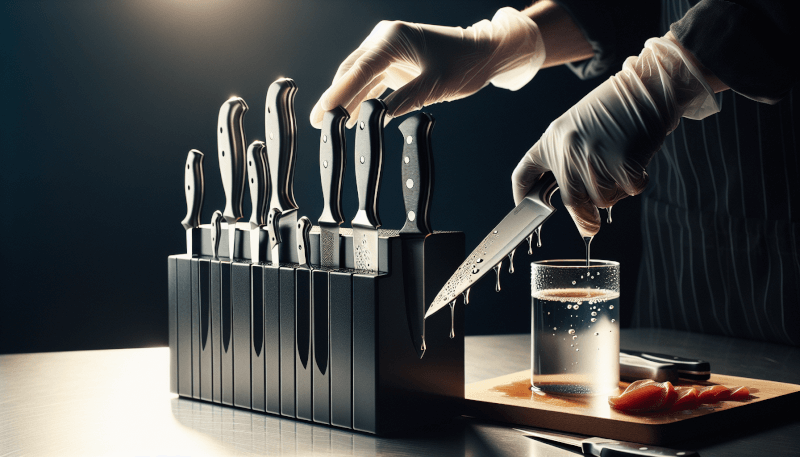Do you love cooking but often worry about cross-contamination in your kitchen? One area that requires extra attention is your kitchen knives. In this article, we will explore effective tips and techniques to ensure that you prevent cross-contamination with your kitchen knives, keeping both your food and your loved ones safe and healthy. By implementing these easy-to-follow steps, you can make your cooking experience more enjoyable and worry-free. So, let’s dive into the world of kitchen safety and learn how to keep your knives clean and contamination-free.

Clean and Sanitize Knives Properly
Wash Knives After Each Use
One of the most important steps in preventing cross-contamination with kitchen knives is to wash them thoroughly after each use. This helps remove any leftover food particles or bacteria that may be present on the blade. Simply rinsing the knife under running water is not enough; you should use hot, soapy water to ensure proper cleaning.
Use Hot, Soapy Water
Hot, soapy water is essential for getting rid of any stubborn residue on knives. The high temperature helps kill bacteria, while the soap helps break down grease and other contaminants. Be sure to thoroughly scrub the blade, handle, and any crevices to ensure a thorough clean.
Pay Attention to the Handle
While it’s easy to focus on cleaning the blade of the knife, it’s equally important to pay attention to the handle. The handle is often overlooked, but it can harbor bacteria and become a source of cross-contamination. Make sure to clean the handle with hot, soapy water and pay attention to any grooves or texture that may trap dirt or bacteria.
Dry Knives Thoroughly
After washing your knives, it’s important to dry them thoroughly before storing them. Moisture can promote the growth of bacteria, so it’s crucial to eliminate any lingering dampness. Use a clean towel to dry the blade and handle, ensuring that no moisture remains.
Sanitize Knives Regularly
In addition to washing and drying your knives, it’s a good idea to sanitize them regularly. Sanitizing helps further reduce the risk of bacterial contamination. You can use a sanitizing solution specifically designed for kitchen utensils or a diluted bleach solution. Be sure to follow the manufacturer’s instructions when using any sanitizing product.
Separate Knives for Different Foods
Designate Knives for Specific Tasks
To minimize the risk of cross-contamination, it’s best to designate specific knives for different tasks. For example, have a separate knife for cutting raw meat, one for vegetables, one for bread, and so on. This prevents the transfer of bacteria from one food to another.
Use Color-Coded Knives
Color-coding your knives can be a helpful visual cue to remember which knife is used for each type of food. Many professional kitchens use color-coded knives to reduce the risk of cross-contamination. Choose a system that works for you, such as using red knives for raw meat, green knives for vegetables, and blue knives for cooked food.
Avoid Using the Same Knife for Raw and Cooked Foods
It’s crucial to avoid using the same knife for both raw and cooked foods. Raw meat can contain harmful bacteria that can contaminate cooked food if the same knife is used without proper cleaning. Always use a separate knife when transitioning from raw to cooked food.
Keep Knives for Vegetables Separate
Vegetables can also harbor bacteria, so it’s important to keep knives for vegetables separate from other types of food. This reduces the risk of cross-contamination between vegetables and other foods, such as raw meat or allergenic ingredients.
Store Knives Properly to Prevent Contact
When storing your knives, make sure to keep them separate from each other to prevent contact and potential cross-contamination. Consider using a knife block or a knife rack with individual slots to keep each knife securely in place. This also helps maintain the sharpness and quality of the blades.

Avoid Cross-Contamination During Food Preparation
Use Cutting Boards and Mats
Using cutting boards and mats is an essential part of preventing cross-contamination while preparing food. These surfaces create a barrier between the knife and the countertop, reducing the chances of transferring bacteria.
Avoid Cutting Different Foods on the Same Surface
To prevent cross-contamination, it’s important to avoid cutting different foods on the same surface without proper cleaning in between. For example, if you’ve cut raw chicken on a cutting board, clean and sanitize it thoroughly before using it for chopping vegetables.
Clean Cutting Boards and Mats Thoroughly
After each use, make sure to clean your cutting boards and mats thoroughly. Wash them with hot, soapy water, paying attention to any grooves or texture that may trap food particles or bacteria. Scrubbing with a brush can help ensure a thorough clean.
Use Separate Cutting Boards for Raw Meats and Other Foods
To minimize the risk of cross-contamination, it’s best to use separate cutting boards for raw meats and other types of food, such as vegetables or fruits. This prevents any bacteria present in raw meat from coming into contact with other foods that may be consumed raw or without further cooking.
Clean Surfaces and Utensils Between Tasks
Between different food preparation tasks, it’s important to clean and sanitize both the surfaces and the utensils used. This helps prevent any potential cross-contamination and ensures a safe and hygienic food preparation environment.
Handle Raw Meats with Care
Use Different Knives for Raw Meats
When handling raw meats, it’s crucial to use separate knives specifically designated for this purpose. This prevents any potential transfer of harmful bacteria from raw meats to other foods.
Avoid Cross-Contamination while Trimming or Deboning
During the process of trimming or deboning raw meats, it’s important to be mindful of potential cross-contamination risks. Make sure to wash your hands and any utensils used during these processes thoroughly afterward to prevent the transfer of bacteria.
Clean and Sanitize Knives Immediately after Handling Raw Meats
After handling raw meats, it’s essential to clean and sanitize your knives immediately. This helps ensure that any potential bacteria are eliminated, reducing the risk of cross-contamination during storage or subsequent use.
Take Extra Precautions for High-Risk Meats like Poultry
Certain meats, such as poultry, carry a higher risk of bacterial contamination. When handling these meats, it’s important to take extra precautions, such as using separate cutting boards and utensils, to prevent cross-contamination.

Be Mindful of Allergens
Separate Utensils for Allergenic Foods
If you or someone in your household has food allergies, it’s crucial to have dedicated utensils for preparing allergenic foods. This helps minimize the risk of cross-contamination and accidental exposure to allergens.
Avoid Cross-Contamination with Allergens
To prevent cross-contamination with allergenic foods, it’s important to thoroughly clean and sanitize utensils and surfaces after each use. This reduces the risk of residue or traces of allergenic foods coming into contact with other foods.
Clean and Sanitize Utensils Used with Allergenic Foods
After using utensils to prepare allergenic foods, make sure to clean and sanitize them thoroughly. This helps eliminate any potential allergens that may be present on the utensils, reducing the risk of cross-contamination.
Educate Others about the Importance of Allergen Cross-Contamination
If you’re cooking for others, it’s essential to educate them about the importance of allergen cross-contamination. Make sure they understand the risks involved and the necessary precautions to take to prevent exposure.
Use Safe and Hygienic Cutting Techniques
Cut Food at Safe Temperatures
To ensure food safety, it’s important to cut food at safe temperatures. This means cutting raw meats when they are at their coldest, just out of the refrigerator, and ensuring that cooked foods are cooled to the appropriate temperature before cutting.
Avoid Chopping Through Bones
When cutting meat, it’s important to avoid chopping through bones whenever possible. Bones can potentially harbor bacteria, and cutting through them with a knife can increase the risk of cross-contamination.
Do Not Lick or Taste the Blade
While it may be tempting to lick or taste the blade of a knife, this is highly unhygienic and can lead to cross-contamination. Always use a clean spoon or another utensil to taste food.
Avoid Wiping the Knife with Fingers
Wiping the knife blade with your fingers, especially during food preparation, should be avoided. This can transfer bacteria from your hands to the knife blade, increasing the risk of cross-contamination.
Use a Clean Knife for Each Task
Using a clean knife for each task is an important practice to prevent cross-contamination. While it may be tempting to use the same knife for multiple tasks to save time, it’s crucial to prioritize hygiene and use a fresh knife for each new task.

Train and Educate Kitchen Staff
Implement Proper Knife Handling and Sanitization Practices
Proper knife handling and sanitization practices should be implemented in any kitchen setting. Training staff on the correct techniques for cleaning, sanitizing, and storing knives helps maintain a safe and hygienic food preparation environment.
Educate Staff about Cross-Contamination Risks
It’s important to educate kitchen staff about the risks associated with cross-contamination and the steps they can take to prevent it. By creating awareness and providing ongoing training, you can ensure that everyone understands and follows proper practices to minimize the risk.
Provide Clear Instructions for Cleaning and Storing Knives
Clear instructions should be provided to kitchen staff regarding the proper cleaning and storing of knives. This helps standardize the process and ensures consistency in maintaining hygiene and preventing cross-contamination.
Regularly Reinforce Training and Monitor Compliance
Reinforcing training and regularly monitoring staff compliance is essential in maintaining proper knife handling practices. Regular reminders, refresher courses, and consistent supervision can help reinforce the importance of following food safety guidelines.
Maintain Sharp and High-Quality Knives
Sharp Knives Reduce the Risk of Slipping
Maintaining sharp knives is not only important for efficient cutting but also for safety. Dull knives are more likely to slip and cause accidents, increasing the risk of cross-contamination. Regularly sharpening your knives ensures they remain safe and effective.
Damaged Knives Can Harbor Bacteria
Damaged knives, such as those with cracks or loose handles, can harbor bacteria and pose a risk to food safety. Regularly inspect your knives for any signs of damage and replace them if necessary.
Invest in High-Quality Knives
Investing in high-quality knives is an important step in maintaining food safety. High-quality knives are less likely to chip or break, reducing the risk of cross-contamination. They are also easier to clean and maintain.
Regularly Sharpen and Maintain Knives
Regularly sharpening and maintaining your knives is essential for both safety and performance. Dull knives are not only inefficient but also increase the risk of accidents and cross-contamination. Follow the manufacturer’s instructions for sharpening and maintaining your knives.

Follow Hygiene and Food Safety Guidelines
Adhere to Good Personal Hygiene Practices
Maintaining good personal hygiene is crucial for preventing cross-contamination with kitchen knives. Wash your hands thoroughly before handling knives or food, and avoid touching your face or hair during food preparation.
Keep Work Surfaces and Utensils Clean
Cleanliness is key in preventing cross-contamination. Keep work surfaces and utensils clean at all times, regularly sanitizing and disinfecting them. This helps eliminate bacteria and reduces the risk of contamination.
Follow Proper Food Storage and Temperature Guidelines
Proper food storage and temperature control are crucial to prevent bacterial growth and cross-contamination. Make sure to follow recommended guidelines for storing food in the appropriate temperature range, both before and after preparation.
Implement HACCP Principles
Implementing Hazard Analysis and Critical Control Points (HACCP) principles is an effective way to prevent cross-contamination with kitchen knives. HACCP involves identifying and controlling potential hazards in food production, including cross-contamination risks.
Seek Professional Advice
Consult with a Food Safety Expert or Health Inspector
If you have specific concerns or questions regarding cross-contamination and kitchen knife hygiene, it’s always a good idea to consult with a food safety expert or a health inspector. They can provide tailored advice based on your specific circumstances.
Attend Food Safety Training or Certification Programs
To further enhance your knowledge and skills in food safety and cross-contamination prevention, consider attending food safety training or certification programs. These programs provide comprehensive training on best practices and industry standards.
Stay Up-to-Date with Industry Standards and Best Practices
Food safety guidelines and best practices evolve over time, so it’s important to stay updated with the latest industry standards. This can be done by regularly checking reputable sources, attending seminars or conferences, and following industry publications.
Preventing cross-contamination with kitchen knives is crucial for ensuring food safety and reducing the risk of foodborne illnesses. By following proper cleaning and sanitization practices, using separate knives for different foods, avoiding cross-contamination during food preparation, handling raw meats with care, being mindful of allergens, using safe cutting techniques, training and educating kitchen staff, maintaining high-quality knives, and following hygiene and food safety guidelines, you can create a safe and healthy food preparation environment. Remember to seek professional advice when needed and stay informed about industry standards to ensure you are practicing the best possible methods for preventing cross-contamination with kitchen knives.


